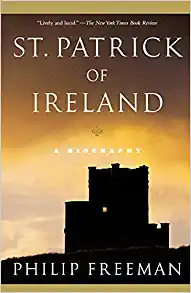Videos suggested at the end of this video are not necessarily endorsed by this website
Bet you didn’t know that originally the color for St. Patrick’s Day was blue. According to a Time Magazine article of March 16, 2010, the clover became a national symbol in the Irish Rebellion in 1798. Then the green spread to the uniforms. Between that and the green fields of Ireland, green took over for blue.
Possibly one of the first things that come to mind when you think of St. Patrick’s Day is the “leprechauns” of Irish myth. The explanation at reference.com says they are thought of as members of the fairy family. They are usually shown as small old men dressed in green with a leather apron and shoes bearing large silver buckles. They are believed to be mischievous, causing little mishaps in homes and sometime riding sheep or the family dog for fun. You’ve no doubt heard of “the pot of gold at the end of the rainbow.” According to the myth, leprechauns have hidden a pot of gold at the end of the rainbow. You might try going to the end of the rainbow to get it, but you’ll have trouble catching a leprechaun to help you find it. Fairies have supposedly given them the ability to disappear.
Did you ever wonder why there is so much drinking on a day to honor a saint? At learn.kegerator.com, I learned that people observing the restrictions on food and alcohol for the season of Lent (40 days of preparation for Easter) were allowed to put aside the restrictions for the St. Patrick’s Day feast. That’s how excessive drinking became a part of the St. Patrick’s Day celebration. I think it’s a very unfortunate distraction.
FOCUSING ON THE REAL STORY OF ST. PATRICK
 The whole reason we celebrate St. Patrick’s Day is, of course, St. Patrick. Did you know that St. Patrick was not a native of Ireland? Did you know that his story is really a pirate story? No kidding! It’s true. You may have heard that he used a shamrock (3-leaf clover) to teach the concept of the Trinity. Such legends have come from fictitious stories written about him, but the real story of St. Patrick needs no embellishment.
The whole reason we celebrate St. Patrick’s Day is, of course, St. Patrick. Did you know that St. Patrick was not a native of Ireland? Did you know that his story is really a pirate story? No kidding! It’s true. You may have heard that he used a shamrock (3-leaf clover) to teach the concept of the Trinity. Such legends have come from fictitious stories written about him, but the real story of St. Patrick needs no embellishment.
I was blessed to find a well-written, thoroughly researched, fascinating history of the life of St. Patrick. It was written by Philip Freeman, a professor and a recognized expert in Greek, Roman, and medieval culture and Celtic studies. His book is entitled St. Patrick of Ireland—A Biography. I will give you a glimpse into St. Patrick’s life by means of what I learned from reading his book. You may want to read the entire book yourself.
The basis for what we know for sure of St. Patrick’s life is found in two letters he wrote. Though the original letters have been lost, some ancient copies with various parts of the letter have survived. The two letters were written directly from St. Patrick’s heart. The author of this biography about him greatly enriches what we know from the letters with descriptions of the cultures and happenings in that part of the world in the slice of history around St. Patrick’s lifetime.
ST. PATRICK’S BACKGROUND
St. Patrick was born in Britain sometime close to the end of the fourth century. He came from an aristocratic family of landowners. Britain was a part of the Roman Empire at that time. Patrick’s grandfather was a priest, but in those days priests were not restricted from having a wife and family. Patrick’s father was a deacon in the church and a city councilor, responsible for collecting the heavy taxes imposed by the Romans. The clergy were exempt from that heavy tax burden.
WHAT WAS BRITAIN LIKE IN ST. PATRICK’S TIME?
Britain was basically agricultural. The Romanization of Britain had eventually become peaceful, but sometime around the time of Patrick’s entry into the world, Britain suffered attacks from the Picts, the Saxons, and the Irish. They were eventually driven off.
around the time of Patrick’s entry into the world, Britain suffered attacks from the Picts, the Saxons, and the Irish. They were eventually driven off.
There were shrines to multiple Roman and Celtic gods in the towns of Britain in Patrick’s day. Small church buildings began to spring up in Britain in the fourth century. The Christians of Patrick’s family were probably proud of their local church. Patrick’s family had a house in town and a nearby country estate.
Slaves were brought in from all over the Roman Empire. It wasn’t just the wealthy who had slaves. Patrick may have heard the Irish language from some of their slaves. Patrick’s primary language was probably British, a Celtic tongue, but the Roman nobility studied Latin from childhood. Latin was the language of the government. The third phase of their education, from age 15 to 25, involved perfecting skills learned earlier and learning the skill of public speaking. Patrick knew all the stories from the Bible, but his heart wasn’t in it. He rebelled against his family’s faith.
ST. PATRICK’S TRAUMATIC EXPERIENCE
One devastating night, when Patrick was just under age 16, he was awakened by barbaric pirates from Ireland. They slapped chains around Patrick’s neck and hauled him and others to their awaiting ship. They were cold-blooded businessmen. Elderly men and women, infants, and children would have been ruthlessly killed. No one would want to buy them. Patrick’s life had taken a drastic turn. He no longer had a life of privilege. He doubted he would ever see his family again. For six years he served the master who bought him. He was given the job of tending sheep. He would have watched over the sheep through the night when the lambs were being born, helped slaughter for meat, and sheered the sheep for wool.
God began to work in Patrick’s heart. He said he prayed “through snow and frost and rain.” The thought of a loving and caring God became important to him. No doubt the Bible stories and prayers he had learned as a child began to fill his mind. He said he got up before the sun came up every morning to say 100 prayers. Then he would say another 100 every night. He even began to fast.
 THE JOURNEY HOME
THE JOURNEY HOME
As Patrick lay asleep one night, a voice spoke to him in a dream. The voice said, “You have fasted well—soon you will be going home.” Escape would be a very risky matter. Ships departing for Britain did not depart from the west coast, where he was. A fugitive was in the same class as a robber or killer, under Irish law. The next night, Patrick heard the voice once again. This time it said, “Behold, your ship is ready,” and it told him where the ship was.
The ship was in a harbor about 150 to 200 miles away, with hills, mountains, and marshes between him and the ship. For some reason, when the ship arrived back in Britain he and the crew had a long trek. When they ran out of food, Patrick told the mocking sailors that nothing was impossible for God. After he prayed, a large herd of pigs crossed the road in front of them. The rest of the trip was blessed with plenty of food and good weather.
A SURPRISING CALL
When Patrick arrived at home, his family must have been shocked to see him. Patrick returned a different person, inside and out. Upon his return, he discovered that Rome had begun losing its grip on the Empire. Probably to his family’s dismay, after Patrick came back he received two visions calling him to go back to Ireland. He was called to the brutal people who had stolen him and sold him into slavery.
There are some years of mystery between Patrick’s escape back to Britain and his return to Ireland. It would take years of preparation to qualify to be a bishop to minister to the people. It’s probable that he received his training as a deacon and priest by age 30, then earned his position as bishop after returning to Ireland.
 ST. PATRICK’S CHALLENGING MINISTRY
ST. PATRICK’S CHALLENGING MINISTRY
Patrick said he ministered in “the most remote parts of the island—places at the very edge of the world, places no one had ever been before.” He wanted to serve those who were already Christians and preach the Gospel to the pagans. He believed we were approaching God’s Judgment Day. Religions in Ireland had countless gods and goddesses. Ireland was filled with autonomous tribes, each having its own “king.” Only poets, Druids, and certain tribal leaders could trespass into another tribe’s territory. In order to avoid being killed, Patrick would have to travel under the protection of one of these select few. His evangelization required him to pay local kings for their protection.
Irish warriors liked to decapitate their enemies and hang up their head in their homes. Ireland had religious figures called “Druids,” often women. Information about the Druids in Gaul (the area of present-day France) gives us an idea what Irish Druids might have been like. The Gaulish Druids are believed to have “studied the ways of nature, supervised sacred rites, presided over public and private disputes, and were able to stop wars simply by stepping between opposing armies.” They also tried to predict the future, believed in reincarnation, and terrified soldiers by calling down curses. The Druids were no longer honored as Christianity spread.
As Roman rule slipped away in Britain, tyrants arose to defend Britain against invaders. Many of these tyrants were Romano-British nobility, most of them professing to be Christians. Because the tyrants kept the peace, the church apparently closed their eyes to their abuses. The morning after Patrick had just baptized a group of new Christians, he received word that the new Christians were attacked by British raiders while returning to their homes. Most of the men were killed, and the women and children were kidnapped. The heartbroken Patrick sent a seething letter to anyone under the rule of a leader named Coroticus, denouncing the horrible attack on the Irish Christians.
ST. PATRICK’S DEVOTION DOUBTED
The second letter we have to give us a look into Patrick’s life was a letter of defense. In the letter Patrick expressed his lack of confidence in his ability to write well in the Latin language due to the education he missed because of his kidnapping. He began by sharing his life experiences and conversion. The he tells how the attacks by his “superiors in the Church” made him feel so “beaten down” that he though he “would never rise again.” He said the “pretense of their attack” was about a sin early in his life that was exposed by a close comrade to whom he had confessed it years before. A vision confirmed that God was angry about the attack. Patrick defended his refusal to accept gifts of jewelry offered by women in order to avoid criticism by the non-Christians, and he defended his payments to local kings that allowed him to travel around and preach the Gospel. Apparently the Church suspected him of corruption, and some may have been jealous that a man with so little education had such great success. It is likely they were also angered by the fact that Patrick sent a letter directly to Coroticus’ soldiers.
Rules forbade priests and bishops from getting involved in issues of congregations under other bishops and required them to deal only with their bishops. But time was of the essence. Patrick begged Coroticus and his soldiers to bring back the women and children they had kidnapped.
ST. PATRICK’S LEGACY
We do not know what result came from Patrick’s letter to the soldiers of Coroticus, nor do we know whether he was able to stay in Ireland for the remainder of his days after his letter of defense, as he wished. The place of his burial is uncertain. Even the date of his death is pretty much a guess. According to Wikipedia, the St. Patrick’s feast day was instituted in the early 17th century. According to irishcentral.com, he was never officially canonized as a saint because there was no canonization process until the 12th century. The biography states that Patrick had fallen into relative obscurity for hundreds of years, although beginning a couple of hundred years after his death several fictitious accounts of his life were written.
 In Professor Freeman’s book, there are many other interesting details recounted of the history and culture surrounding Patrick which help bring the story to life. There are also conjectures about what may have happened. The author provides his own translation of St. Patrick’s two Latin letters. If you acquire the book and read the letters for yourself, you will find that the letters let you see into the heart of a man who is full of humility, full of knowledge of the Word of God, full of the Holy Spirit, and completely sold out to the spreading of the Gospel.
In Professor Freeman’s book, there are many other interesting details recounted of the history and culture surrounding Patrick which help bring the story to life. There are also conjectures about what may have happened. The author provides his own translation of St. Patrick’s two Latin letters. If you acquire the book and read the letters for yourself, you will find that the letters let you see into the heart of a man who is full of humility, full of knowledge of the Word of God, full of the Holy Spirit, and completely sold out to the spreading of the Gospel.
It’s fun to say “Top o’ the mornin’ to ya” and pinch those who aren’t wearing green on St. Patrick’s Day, but it’s also important to remember this man who was such a great example of a Christian. His second letter shows that he was a man very grateful for the grace of God. In the letter he wrote the following: “This much I know for certain—before God humbled me I was like a stone stuck deep in a mud puddle. But then God came along and with his power and compassion reached down and pulled me out, raised me up, and placed me on top of a wall.” In 1970 Dottie Rambo wrote a song called “He Looked Beyond My Faults” to the tune of “Danny Boy.” I think St. Patrick would have loved it. Click on the picture below to hear it.
Videos suggested at the end of this video are not necessarily endorsed by this website.


Leave A Comment